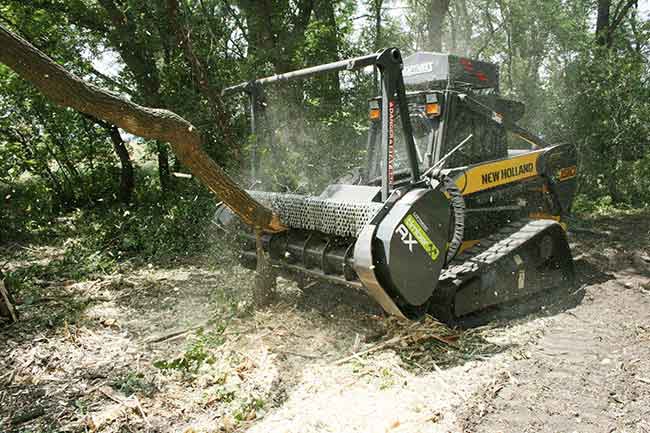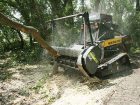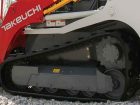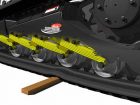
Peek underneath
By David Steger Takeuchi
Features Tech tipsThe undercarriage design of a track loader contains some of the most critical components of the machine. It is also subjected to the brunt of the punishment in extreme operating conditions.
 It gets dirty under there. Check your track loader’s undercarriage after each rental for accumulated dirt and lodged debris to keep your equipment in top operating condition. The undercarriage design of a track loader contains some of the most critical components of the machine.
It gets dirty under there. Check your track loader’s undercarriage after each rental for accumulated dirt and lodged debris to keep your equipment in top operating condition. The undercarriage design of a track loader contains some of the most critical components of the machine.While the life expectancy of a compact track loader’s undercarriage depends on many factors – including application and ground conditions – the main influence on the life of a machine’s undercarriage comes from the actions of the operator, along with its associated impact on the cost of ownership.
Rigid vs. suspended undercarriage
There are two types of undercarriages: rigid and suspended. In a rigid-mount frame, the left and right track frames are fixed to the main frame by bolting or welds. A suspension undercarriage uses movable track frames supported by torsion springs, or in some cases rollers suspended by a leaf spring.
The rigid undercarriage is most like a bulldozer that was built for grading or pushing. The lower boom stops also play a critical role in the grading and pushing ability of a machine.
The soft ride of a suspended undercarriage can be accomplished on rigid undercarriage designs by properly adjusting the deluxe suspension seat. For operators traveling over rough terrain, they may also consider the ride control option that suspends the boom with an accumulator for improved operator comfort and better material retention.
There are unique advantages to each kind of undercarriage. There are fewer moving parts with a rigid undercarriage, which calls for less maintenance. Fewer moving parts means a rigid undercarriage is more durable and has less to go wrong than suspension track systems. Pound for pound, rigid undercarriages have a higher rated operating capacity and tip load than suspended undercarriages. However, suspension undercarriages typically provide a smoother ride for hard surface or long travel applications by reducing shock and vibration throughout the machine.
Key considerations
The undercarriage will be a large portion of the operating and maintenance cost over the life of the machine, so taking the time to closely evaluate and understand each machine is crucial to your investment choice. Choose poorly and the machine will drain your profits. Choose wisely and reap the benefits of durability, uptime and increased production.
Some key considerations are how the undercarriage is constructed. Look at how much steel is used. Thicker steel equals higher strength. Look at the size of the rollers. Larger diameter rollers mean slower turns, which result in longer bearing life. Larger components typically mean larger bearings, which results in greater capacity, especially with the front roller.
Keeping the undercarriage in top condition
There are a few ways to ensure that the machine’s undercarriage is in top condition. Track maintenance should include proper tensioning, cleaning and inspection and should be done on a regular basis. It is crucial to follow the schedule in the operator’s manual, but inspections should be more frequent when in muddy or abrasive conditions.
Operators should also check for patchy or uneven wear on the tread. If some components were wearing more than others, it would cause additional wear on the other components.
Keeping the machine clean is helpful because it makes it easier to see any issues relating to the undercarriage. Undercarriages drive over rough terrain, which would include rocks, mud, and clay that can get wedged between the components. Having a clean machine at the end of the day makes it easier to see if any loose particles did get wedged into the components.
Each day make sure to check the track for cuts, punters or tears. Sprockets and rollers should be inspected to ensure they are in good condition with no damage, excessive wear or flat spots, which may be an indication of material buildup or bearing seizure. Any oil leakage from rollers, hoses or travel motors should be repaired immediately. It is also recommended to replace the sprockets each time new tracks are installed.
Last, but not least, maintain track tension regularly. You do not want to be too loose or too tight. Being too tight will cause premature wear, while too loose will make the tracks come off entirely.
The best operators know how to get the most performance out of a track loader while still doing their best to minimize wear on a machine. By taking good care of your machine’s undercarriage, your track loader in return, will take good care of you.
Finally, make sure to look at all the models that are offered by a brand and if the components are the same size on both the small and large loaders. If they are, that should raise a red flag. Instead, you should see matched sizes that are optimized for the loaders intended applications.
In real estate, the mantra is location, location, location. For track loaders, it’s durability, durability, durability.
Print this page



Leave a Reply